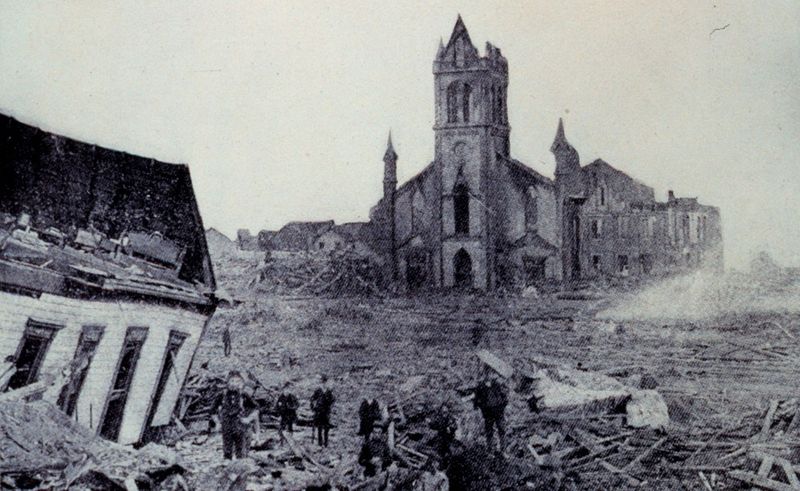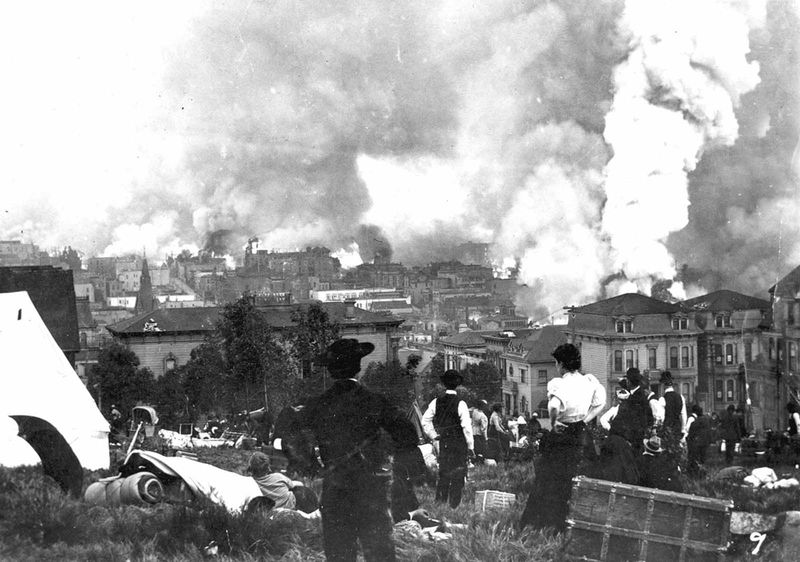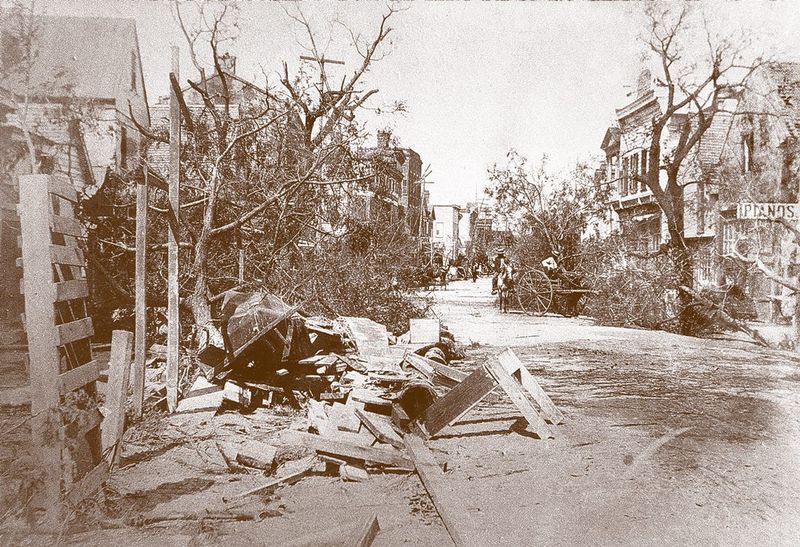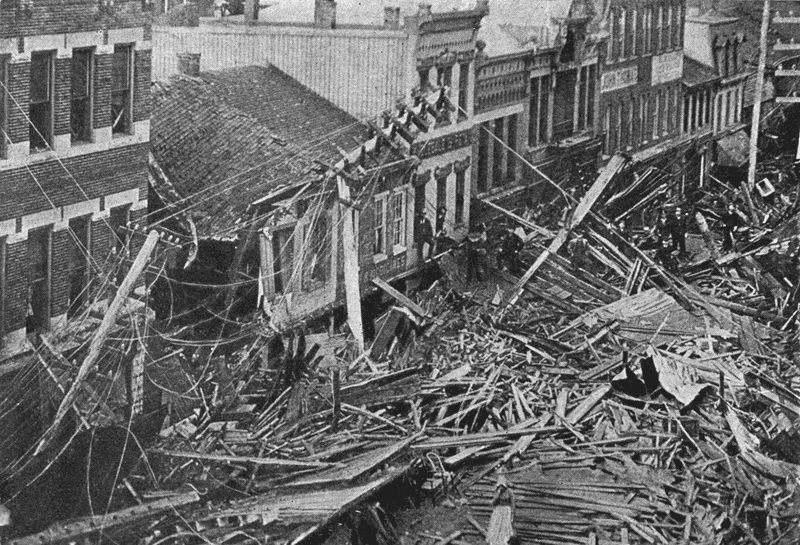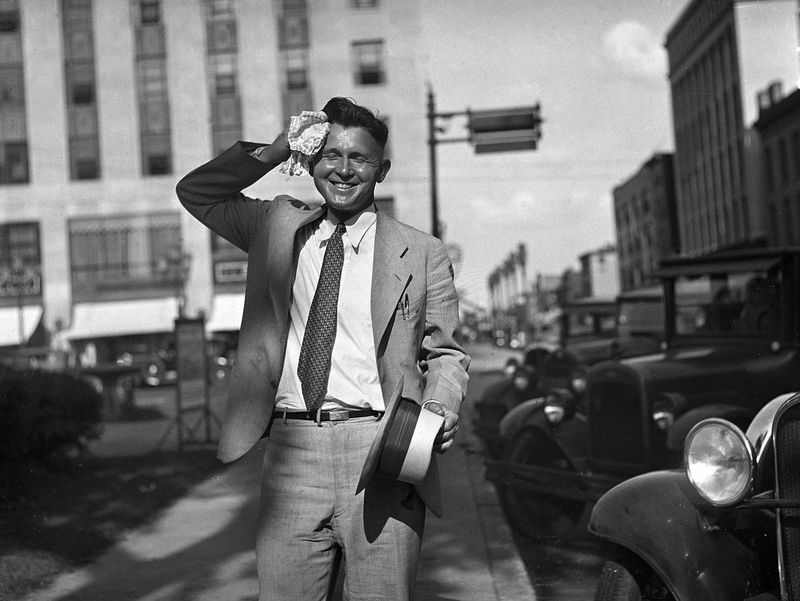Natural disasters have shaped American history in profound and tragic ways. When nature unleashes its full power, the consequences can be devastating for communities across the nation. From coastal hurricanes to inland fires, these catastrophic events have claimed thousands of lives and forever changed the landscape of America. The following list examines the ten deadliest natural disasters that have struck the United States.
1. 1900 Galveston Hurricane: America’s Deadliest Storm
The thriving island city of Galveston never saw it coming. On September 8, 1900, a massive Category 4 hurricane slammed into Texas with winds exceeding 135 mph, bringing with it a 15-foot storm surge that submerged the island.
Bodies floated through streets-turned-rivers as families clung to rooftops. With no warning system in place, residents had little time to evacuate the low-lying island.
The aftermath was apocalyptic – corpses piled so high that burial was impossible, forcing officials to burn bodies for weeks. This single storm killed between 6,000-12,000 people, more than all other American hurricanes combined at that time.
2. 1918 Influenza Pandemic: The Invisible Enemy
Silent and swift, the 1918 flu pandemic swept through America with terrifying efficiency. Unlike typical influenza strains that primarily threaten the elderly, this H1N1 variant proved deadliest for healthy young adults between 20-40 years old.
Streets emptied as cities banned public gatherings. Hospitals overflowed while medical professionals, themselves falling ill, struggled to treat patients with limited resources. World War I troop movements accelerated the spread, creating perfect conditions for transmission.
Approximately 675,000 Americans perished – more than all U.S. combat deaths in WWI, WWII, Korea, and Vietnam combined. Some victims died within hours of showing symptoms, their skin turning blue from lack of oxygen.
3. Lake Okeechobee Hurricane: The Forgotten Flood
Water, not wind, made the 1928 Okeechobee Hurricane one of America’s deadliest disasters. When the Category 4 storm crossed Florida, it pushed the shallow waters of Lake Okeechobee against its southern shore until the makeshift mud dikes catastrophically failed.
A wall of water 6-9 feet high surged across farmlands, drowning entire communities in minutes. Most victims were Black migrant workers whose deaths went largely uncounted in official records.
Bodies were recovered for months afterward, with many buried in unmarked mass graves. The disaster claimed between 2,500-4,000 lives and inspired portions of Zora Neale Hurston’s novel “Their Eyes Were Watching God.”
4. Hurricane Maria: Modern Tragedy in Puerto Rico
Hurricane Maria transformed Puerto Rico into an island of darkness when it struck in September 2017. The Category 4 monster tore through the island’s aging infrastructure, collapsing the entire power grid and leaving 3.4 million Americans without electricity for months.
Hospitals operated on emergency generators while medications spoiled in the heat. Remote communities remained cut off as landslides blocked roads and destroyed bridges. Clean water became scarce as treatment plants failed.
Though initially reported as causing just 64 deaths, later studies revealed between 2,975-4,645 excess deaths occurred in the months following Maria – many from treatable medical conditions exacerbated by the prolonged recovery efforts.
5. San Francisco’s Devastating Earthquake and Firestorm
At 5:12 AM on April 18, 1906, San Francisco jolted awake to violent shaking that lasted 45 seconds but changed the city forever. Buildings crumbled instantly, but the true devastation came after – broken gas lines ignited fires that merged into an unstoppable firestorm.
For three days, flames devoured 500 city blocks as firefighters watched helplessly – water mains had shattered in the quake. Desperate residents fled with whatever they could carry as the inferno consumed Victorian-era wooden structures.
The official death toll of 700 was later revised to over 3,000 as historians discovered city officials had deliberately undercounted to protect San Francisco’s reputation. Nearly 300,000 people were left homeless, living in tent cities for years afterward.
6. Sea Islands Hurricane: Coastal Communities Washed Away
August 27, 1893 brought apocalyptic devastation to South Carolina’s Sea Islands when a Category 3 hurricane made landfall during high tide. Storm surges up to 30 feet completely submerged islands where predominantly Gullah communities lived, giving residents virtually no escape route.
Entire families vanished as homes were swept into the Atlantic. Those who survived clung to rooftops or trees for days until help arrived. The isolated nature of these communities meant news of the disaster spread slowly.
Between 1,000-2,000 people perished, with bodies washing ashore for weeks afterward. The hurricane disproportionately affected African American communities, whose losses received minimal attention in national news, creating one of America’s most overlooked disasters.
7. Johnstown Flood: When the Dam Broke
Rain fell relentlessly on May 31, 1889, swelling Pennsylvania’s Lake Conemaugh behind a neglected dam owned by the elite South Fork Fishing and Hunting Club. When the earthen structure finally collapsed, 20 million tons of water thundered down the narrow valley toward unsuspecting Johnstown.
A 40-foot wall of water carrying houses, trees, and railroad cars slammed into the industrial town at 40 mph. Victims had mere minutes to reach higher ground before being swept away. The flood demolished 1,600 homes and collected debris into a deadly mass at the Stone Bridge.
Oil ignited there, burning many survivors alive. The disaster killed 2,209 people, including 396 children, and remains America’s worst dam failure.
8. Peshtigo Fire: America’s Forgotten Inferno
Overshadowed by Chicago’s Great Fire on the exact same day, the Peshtigo Fire remains America’s deadliest forest fire. On October 8, 1871, a perfect storm of drought conditions and logging debris created a firestorm that consumed 1.2 million acres of Wisconsin forest in just hours.
The blaze generated hurricane-force winds and temperatures reaching 2,000°F, creating fire tornadoes that tossed buildings into the air. Desperate residents plunged into the Peshtigo River, where many boiled alive as the water heated. Others suffocated as the inferno consumed oxygen.
Between 1,500-2,500 people perished in this apocalyptic scene, with some bodies reduced to ash so completely they were never counted.
9. 1936 North American Heat Wave: When Summer Turned Deadly
Summer 1936 brought America to its knees during the height of the Dust Bowl and Great Depression. Temperatures soared to unimaginable heights – 121°F in North Dakota, 120°F in Wisconsin – shattering records that still stand today.
Urban residents suffered most severely as cities became death traps. Concrete and asphalt absorbed heat by day and radiated it at night, preventing any relief. Thousands slept in parks, on rooftops, or along lakeshores seeking cooler air.
Without air conditioning, approximately 5,000 Americans perished from heat-related illnesses. Crops withered across the Midwest, exacerbating the economic catastrophe of the Depression and forcing thousands more from their farms.
10. Hurricane Katrina: A City Underwater
The images remain seared in America’s collective memory: desperate people waving from rooftops, the Superdome packed with evacuees, and bodies floating through flooded streets. Hurricane Katrina made landfall on August 29, 2005, but the true catastrophe came hours later when New Orleans’ levee system failed catastrophically.
Water poured into neighborhoods, trapping thousands who couldn’t or wouldn’t evacuate. The city’s poorest residents, predominantly Black and lacking transportation, suffered disproportionately. Rescue efforts were delayed for days as coordination between agencies collapsed.
The disaster claimed 1,833 lives and displaced more than a million people, creating a diaspora that permanently altered New Orleans’ cultural fabric and exposed deep inequalities in American disaster response.

